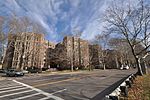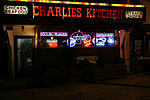Conventual Church of St. Mary and St. John
Cambridge, Massachusetts Registered Historic Place stubsChurches completed in 1936Churches in Cambridge, MassachusettsChurches on the National Register of Historic Places in MassachusettsEpiscopal church buildings in Massachusetts ... and 3 more
Massachusetts church stubsNational Register of Historic Places in Cambridge, MassachusettsRalph Adams Cram church buildings

The Conventual Church of St. Mary and St. John is a historic Episcopal church in Cambridge, Massachusetts. The Romanesque Revival church was built in 1936 to a design by architect Ralph Adams Cram. Cram sought to reproduce 12th century ecclesiastical forms found in the Burgundy region of France. The building was featured in a 1941 architectural magazine. It is home to monks of the Society of Saint John the Evangelist of the Episcopal Church. The church was listed on the National Register of Historic Places in 1982.
Excerpt from the Wikipedia article Conventual Church of St. Mary and St. John (License: CC BY-SA 3.0, Authors, Images).Conventual Church of St. Mary and St. John
Memorial Drive, Cambridge Cambridgeport
Geographical coordinates (GPS) Address Website External links Nearby Places Show on map
Geographical coordinates (GPS)
| Latitude | Longitude |
|---|---|
| N 42.372222222222 ° | E -71.124722222222 ° |
Address
Society of St. John the Evangelist
Memorial Drive 980
02138 Cambridge, Cambridgeport
Massachusetts, United States
Open on Google Maps






